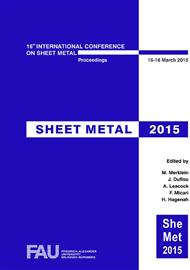[1]
K. Isik, C. Soyarslan, H. Richter, A.E. Tekkaya, Analalysis of formability of advanced high strength steel sheets with phenomenologically based failure criteria with separate treatment of instability, in: 8th European LS-DYNA User Conf., Strasbourg, 2011, pp.1-11.
Google Scholar
[2]
M. Gharbi, C. Labergere, H. Badreddine, C. Soyarslan; A. Weinrich, M. Hermes, S. Chatti, H. Sulaiman, K. Saanouni, A.E. Tekkaya, Advanced experimental–numerical investigations of cold bending of high strength steels, in: Steel research international: Special Edition: 10th Int. Conf. on Technology of Plasticity, 2011, p.877.
Google Scholar
[3]
J. Lemaitre, A continuous damage mechanics model for ductile fracture, J. Eng. Mater. Tech., 107 (1985) 83–89.
Google Scholar
[4]
A. L. Gurson, Continuum theory of ductile rupture by void nucleation and growth: part I – yield criteria and flow rules for porous ductile media, J. Eng. Mater. Tech. 99 (1977) 2-15.
DOI: 10.2172/7351470
Google Scholar
[5]
M.S. Niazi, H.H. Wisselink, T. Meinders, J. Huétink, Failure Predictions for DP Steel Cross-die Test using Anisotropic Damage, Int. Journal of Damage Mechanics 21 (2012) 713-753.
DOI: 10.1177/1056789511407646
Google Scholar
[6]
F. Neukamm, M. Feucht, A. Haufe; K. Roll, On Closing the Constitutive Gap Between Forming and Crash Simulation, in: 10th Int. LS-DYNA User Conf., Dearborn, 2008, pp.21-31.
Google Scholar
[7]
R. Hambli, A. Mkaddem, A. Potiron, Damage prediction in L-bending processes using FEM. Int. J. Adv. Manuf. Tech. 22 (2003) 12–19.
DOI: 10.1007/s00170-002-1435-7
Google Scholar
[8]
S. Thuillier, N. Le Maoût, P.Y. Manach, Bending limit prediction of an aluminum thin sheet, Int. J. Mater. Form. 3 (2012)1 223-226.
DOI: 10.1007/s12289-010-0747-7
Google Scholar
[9]
A. Mkaddem, R. Hambli, A. Potiron, Comparison between Gurson and Lemaitre damage models in wiping die bending processes, Int. J. Adv. Manuf. Tech. 23 (2004) 451–461.
DOI: 10.1007/s00170-003-1701-3
Google Scholar
[10]
I. Tsoupis, S. Hildering, M. Merklein, Numerical investigation of small curvature bendability of high strength low alloyed steel in air and die bending processes, in: Proc. IDDRG 2013, Zurich, 2013, pp.183-188.
DOI: 10.1016/j.proeng.2014.10.065
Google Scholar
[11]
C. Soyarslan, M. Gharbi, A.E. Tekkaya, A combined experimental-numerical investigation of ductile fracture in bending of a class ferritic-martensitic steel, Int. J. Plasticity 49 (2012) 1608-1626.
DOI: 10.1016/j.ijsolstr.2012.03.009
Google Scholar
[12]
N. N., Advanced High Strength Steel (AHHS) - Application Guidelines, Version 5. 0; International Iron & Steel Institute – Committee on Automotive Applications, May 2014, www. worldautosteel. com, 12. 09. (2014).
Google Scholar
[13]
I. Tsoupis, S. Hildering, M. Merklein, Prediction of Damage in Small Curvature Bending Processes of High Strength Steels Using Continuum Damage Mechanics Model in 3D Simulation, Prod. Eng. Res. Dev. 7 (2013)2-3 239-249.
DOI: 10.1007/s11740-012-0441-3
Google Scholar
[14]
I. Tsoupis, M. Merklein, A New Way for the Adaption of Inverse Identified GTN-Parameters to Bending Processes, in: 13th Int. LS-DYNA Users Conf. 2014, Dearborn, 2014, pp.1-14.
Google Scholar
[15]
M. Merklein, M. Geiger, M. Kaupper, Tribology and influence of tool coatings on frictional conditions within forming of advanced high strength steels, in: Proc. 7th Int. Conf. THE Coatings, Thessaloniki, 2008, pp.39-46.
Google Scholar
[16]
R. Hill, A Theory of the Yielding and Plastic Flow of Anisotropic Metals, Proc. of the Royal Society of London, Series A. 193 (1948) 281-197.
Google Scholar
[17]
F. Barlat, D.J. Lege, A. Brem, A six-component yield function for anisotropic materials, Int. J. Plasticity 7 (1991) 693-712.
DOI: 10.1016/0749-6419(91)90052-z
Google Scholar


